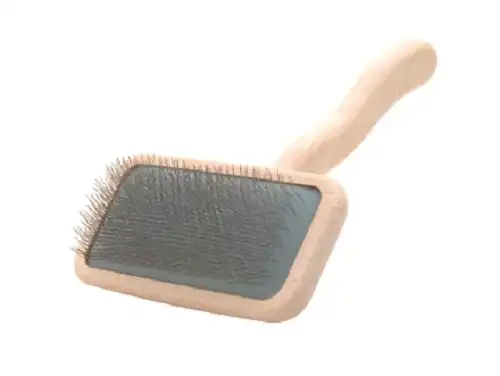Yorkie Colors – Yorkshire Terrier Coat Colors [Photo Guide and Infographic]
These small and tenacious dogs were originally bred as hunters. They are known for their remarkable bravery, with their enthusiastic personalities also making them great companions for families and adults alike.
There are quite a few color variations for Yorkshire Terriers – with four being recognized by the AKC (and quite a few commonly seen around today).
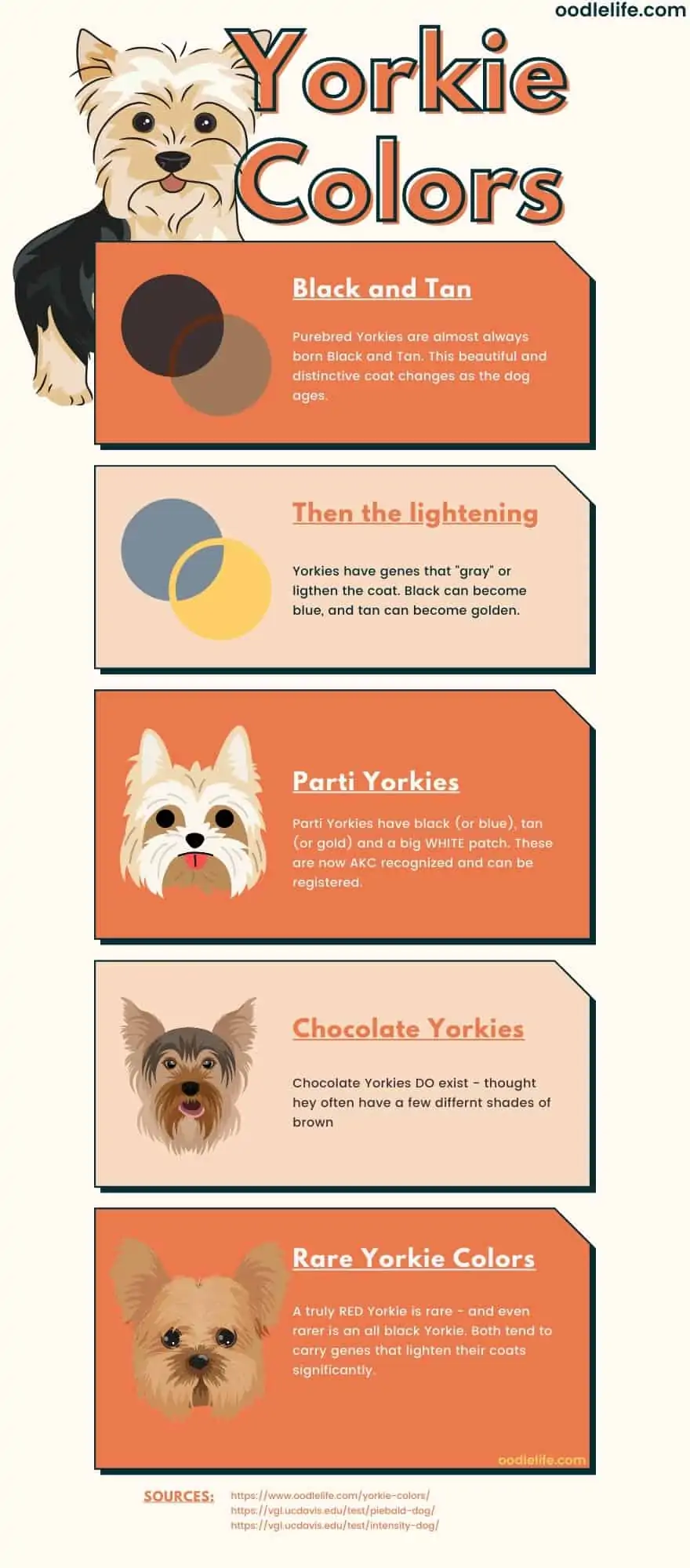
Yorkie Coat Colors
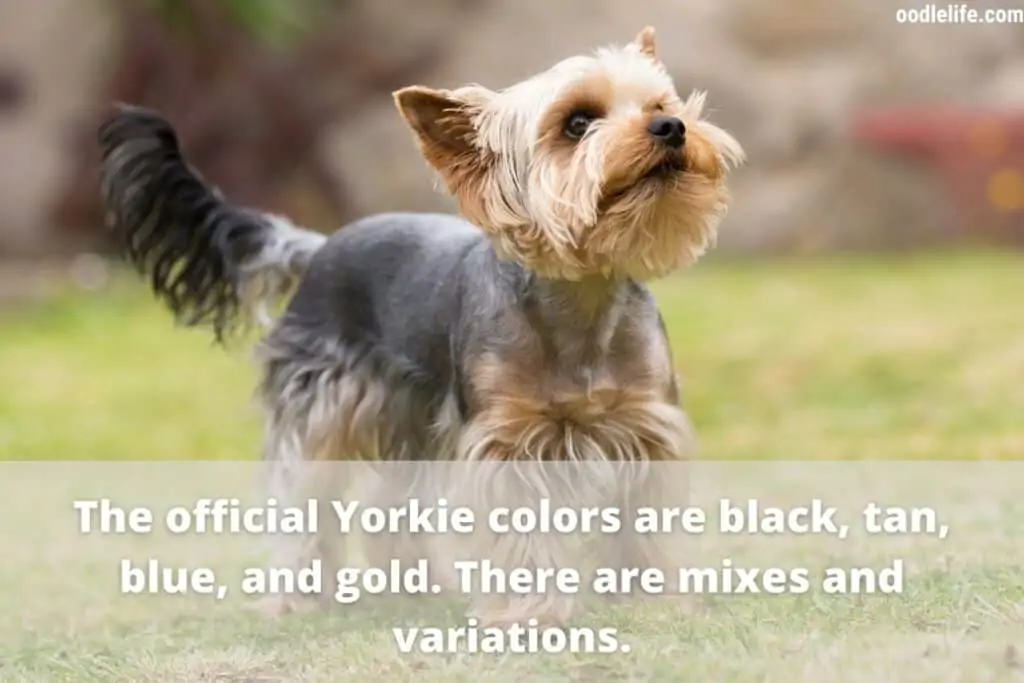
The common colors that are officially recognized by the AKC include black and tan; blue and tan, black and gold, and blue and gold.
The AKC now also recognized that “Parti” Yorkies are an official color type of purebred. These Parti’s are black, tan, and white.
AKC designation really only matters if you intend to compete in dog shows. The vast majority of us will not be impacted and can pick and shade of coat without and consequence.
Beyond this, there are chocolate coats, black coats, and red-legged (red Yorkies). There are also Golden Yorkies.
[Note that blonde and sable Yorkies typically refer to a Golden coat, and brown Yorkies are grouped with Chocolate Yorkies.]
Read on for our photo guide to Yorkie colors and coats!
Black & Tan Coat Yorkies
This is probably the most popular coat pattern among all breeds. It is very easy to see where they come from because it looks like two separate patches of fur.
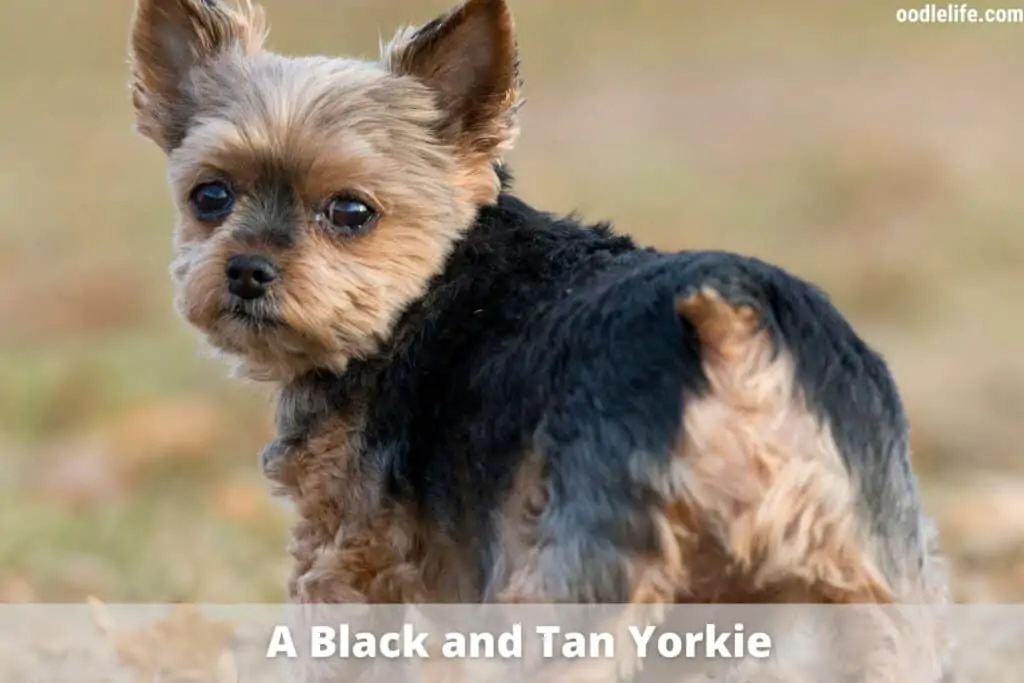
You typically see a black coat on the back and sometimes the head of the dog. When a Yorkie is a puppy it will be jet black that is striking in its purity.
Yorkie puppies are born with black and tan coats, although some might describe them as black and brown.
The tan will typically be seen on the inside of the ears, tips of the ears, around the mouth, chest, feet, and sometimes tail. The exact amount of brown/tan really depends on the individual dog and expect significant variation.
As the Yorkie ages you would expect the black part of the coat to turn blue. This begins as easily as 6 months and continues for years. If your dog still has its deep black coat after meeting maturity – then it has very fortunate gene expression and lacks the graying gene.
As your dog ages you may notice that the hair is closer to the original pigment/color the closer it sits to the skin. So a summer cut might revive a black and tan coat that has lightened.
Black and Gold Coat Yorkies
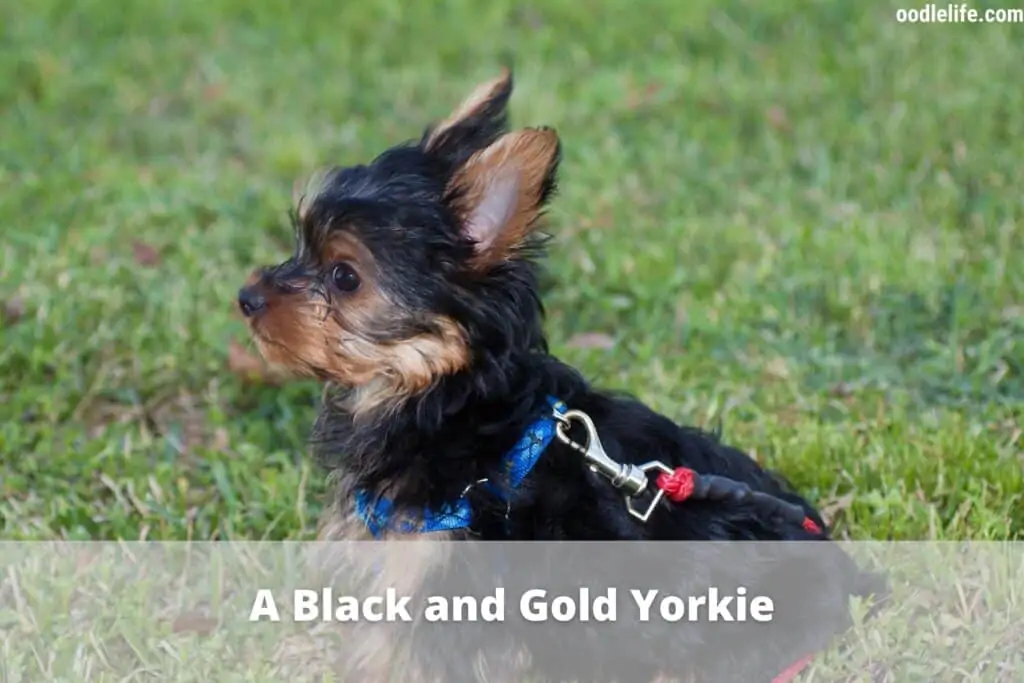
This combination has been seen commonly in the last few decades. The torso and back of the dog are often still black, but the areas that are tan for a Brown and Tan are actually quite a bit lighter.
A Yorkie that has an adult coat of black and gold does have a graying gene. This is why their coat is typically lighter. The graying gene can affect both the black AND the tan colors resulting in a coat that lightens.
This is one of the most common coat types. The graying genes are common and passed on easily.
Blue and Tan Coat Yorkies
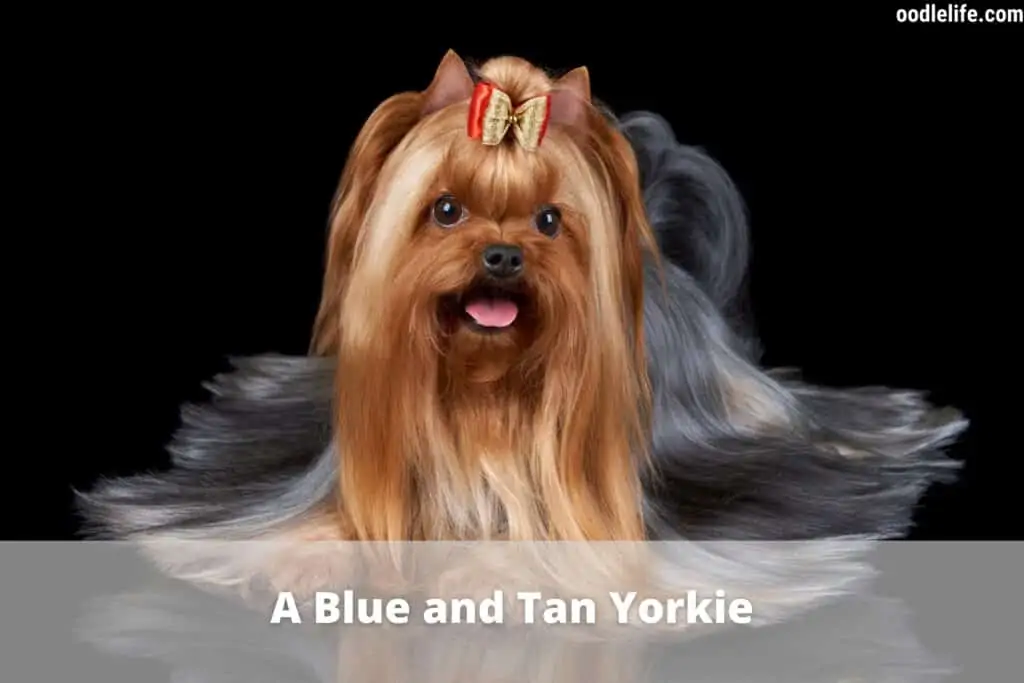
Blue Yorkies start out black as puppies, then become blue as they grow up, thanks to the graying genes.
Blue coat Yorkies typically are born with a black coat. You need to look to the parents to predict whether their coat will lighten.
A Yorkie that is born with a blue coat has a high risk of being “blue born” (which means they may be unhealthy or become unwell as they age. This is just the nature of how the genes express.
Some people say that their blue coat Yorkies tail and/or feet are darker than the rest of the coat. This is not always seen by owners.
Blue and Gold Coat Yorkies
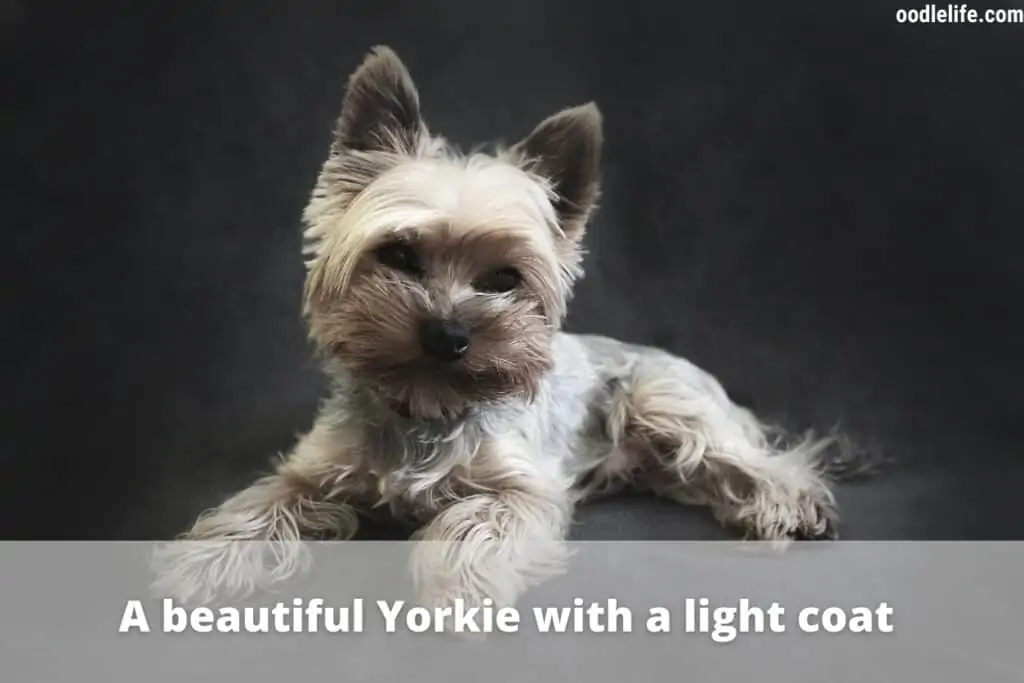
Just like Blue and Tan coat Yorkies, a Blue and Gold coat Yorkshire Terrier is typically born with a rich and deep black coat (and golden or tan markings).
You find out that they are blessed with a shimmery and beautiful blue coat as they age.
These are all caused by genes, so look to the parents and litter history if predicting the coat color is truly important to you.
Parti Coat Yorkies
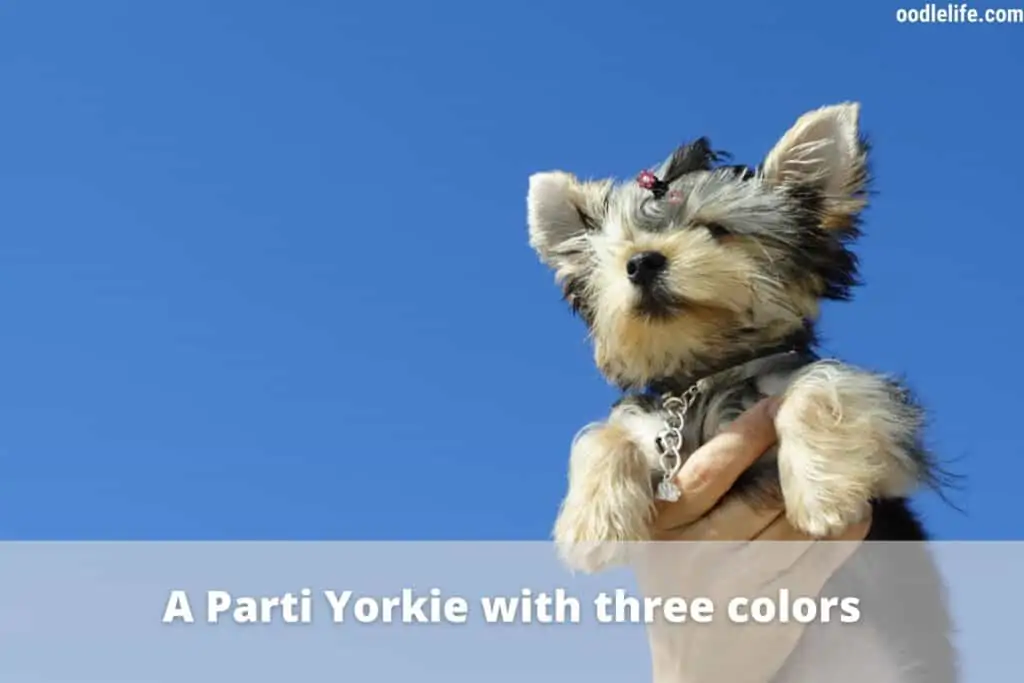
The now officially recognized Parti coat color is a unique combination of blue, tan, and white.
This combination (including actual white hair) is rarer because of the recessive nature of the genes needed to express the combination. White is often the major coat color. Despite this, you don’t often see a fully white Yorkie.
Parti coloring also includes situations where a Yorkie is blue, tan, and has chocolate instead of the white.
Both parents would need to have the recessive piebald gene to get the white coat. This is rare. It also expresses in a way that means that even if both parents have the potential, you still might not get any Yorkie parti puppies. (The UC Davies Vet School Guide to Piebalnd genetics).
Parti coat Yorkies typically cost more too. This is just a feature of them being less common than the other color combinations. In much of the US expect to pay $2500 USD for a parti coat Yorkie (as opposed to 1-2000 USD for a regular purebred Yorkie).
Chocolate Coat Yorkies
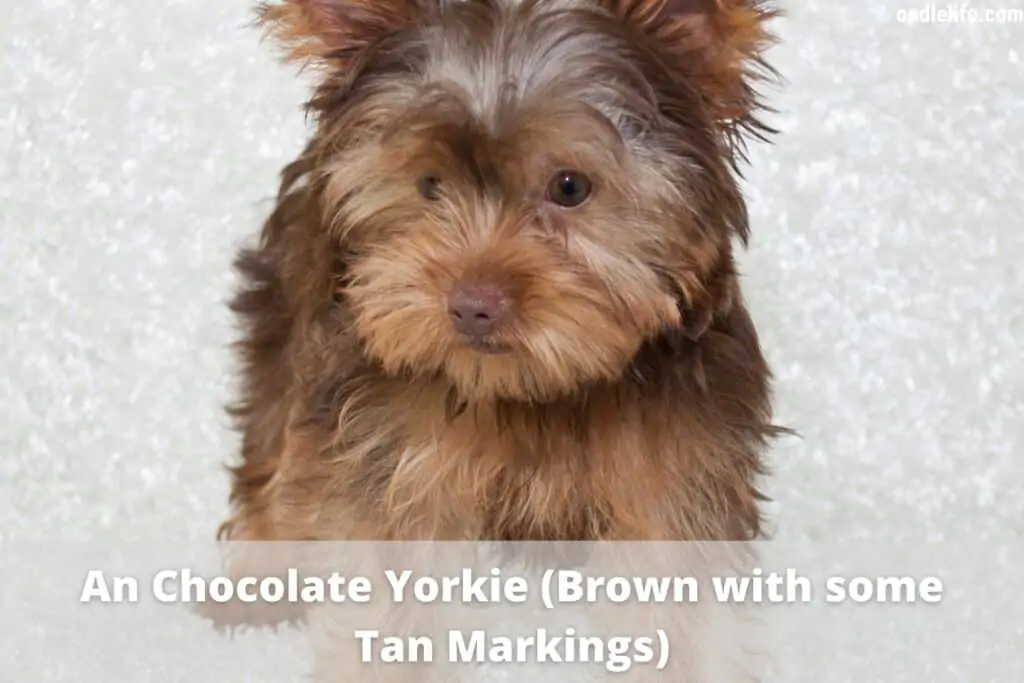
Just like most dog breeds, “chocolate coat” is a fancy way of describing a brown dog. You get a chocolate coat when a mostly black Yorkie (caused by the eumalenanin pigment) also has a gene that lightens the coat.
Chocolate coat Yorkies are also sometimes thought of as a variant of a tan Yorkie. This can allow them to be registered with the AKC and some other international organizations. Their coats typically lighten as they age anyway to a tan color.
Sometimes breeders are a little creative and crossbreed Yorkies with other breeds to get a rich chocolate coat. If purebred status matters to you, clarify with the breeder before adopting.
A truly BLACK Yorkie?
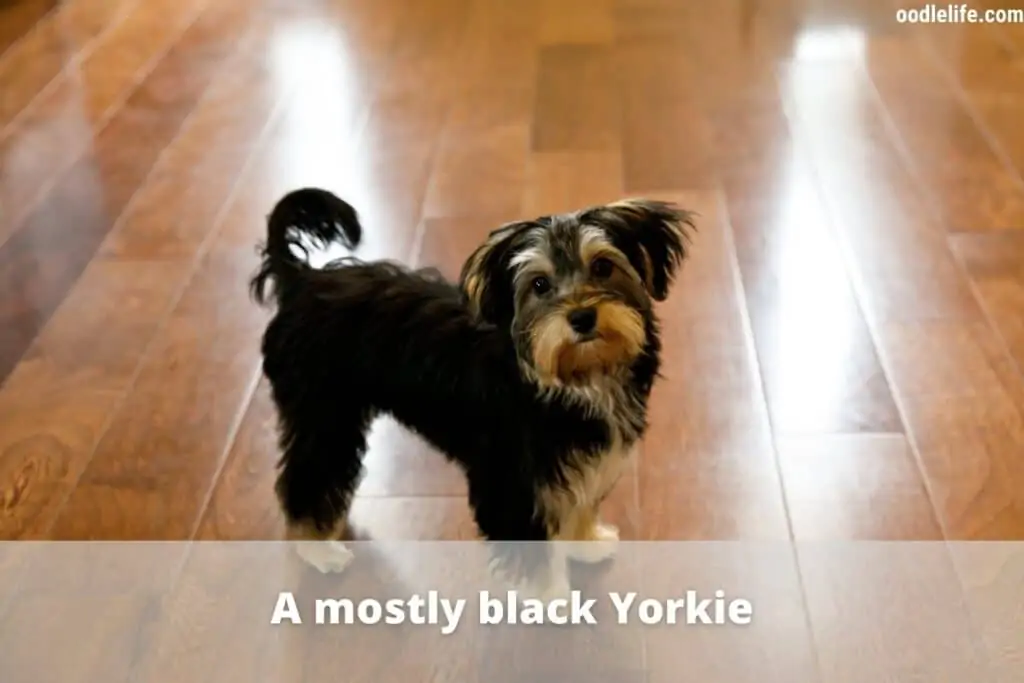
Because of the way that Yorkies carry gray genes (and also the nature of being a purebred) – there is no such thing as a truly all-black Yorkie.
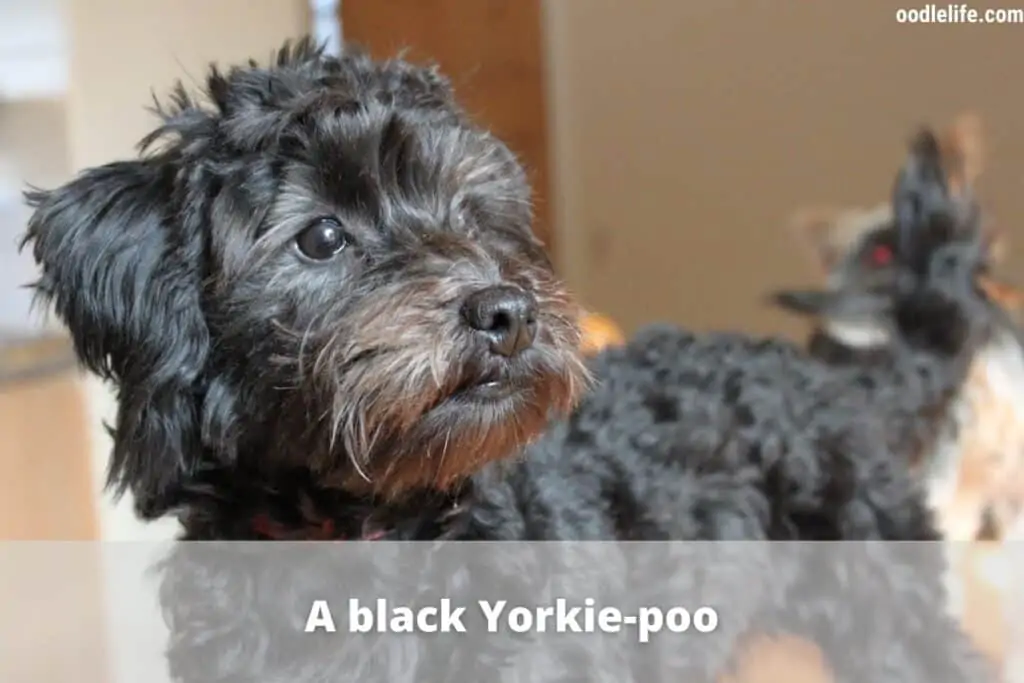
There are however crossbreeds (like the Yorkie poo Poodle Mix above) that may have a long-lasting black coat.
If you are pretty certain your new purebred Yorkie has an all-black coat, don’t become too attached. Almost always there are some patches of brown which will expand and lighten as your Yorkie ages.
Golden Yorkie Coat
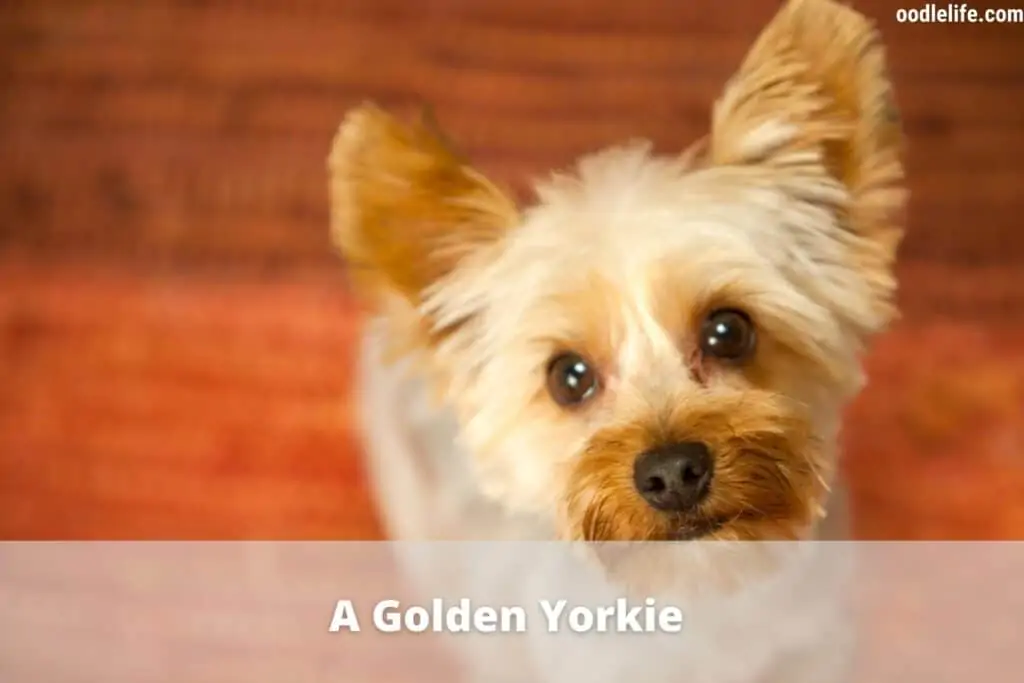
There are plenty of Golden color Yorkies that have strong genes that gray and lighten their coats. They are often born with tan or darker coat – but will see significant change as the years pass.
It is uncommon to have a single-colored Yorkie coat – but it does happen. You typically expect the dark Yorkie eyes and nose pigment to still be present. Quite the striking contrast!
Given that both parents would need to be golden and have specific genes, you might be waiting a long time if you want a pure golden Yorkie.
Yorkie Coat Color is determined by Genes
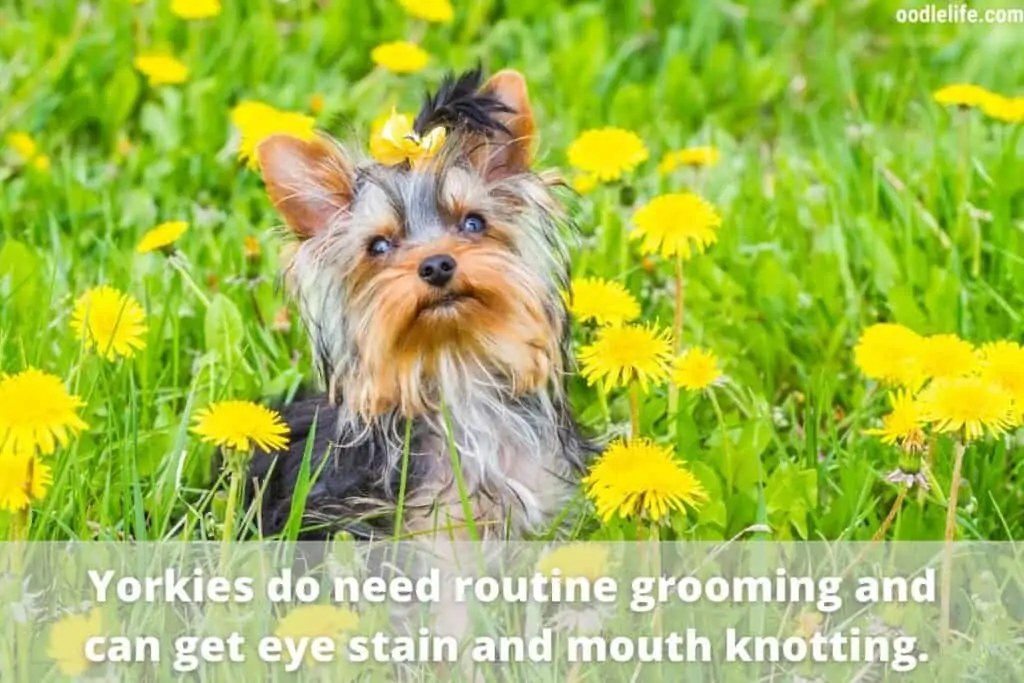
Yorkie dogs are mostly black because of the genes they strongly carry. The Eumalenin (black) primary pigment is strongly carried and results in the deeply black coats you see for many Yorkie puppies.
The other gene that influences the coat color is phaeomelanon (red) and this influences the richness of the brown, tan, or golden portion of the Yorkie coat.
The final influencing genes are the graying genes that many Yorkies carry.
If Yorkies did NOT have any graying genes, we would see a lifetime of Black and Tan or Black and Gold Yorkie coats with no major transition as they age.
However Yorkies have a tendency to have graying genes that weaken the eumelanin pigment. This is why a coat can start black and tan (or black and gold) and fade to blue or even lighter.
Yorkies rarely have coat fade the pure white – but it is possible! It all comes down to genes and luck.
Does the Yorkie Puppy Coat Change Color?
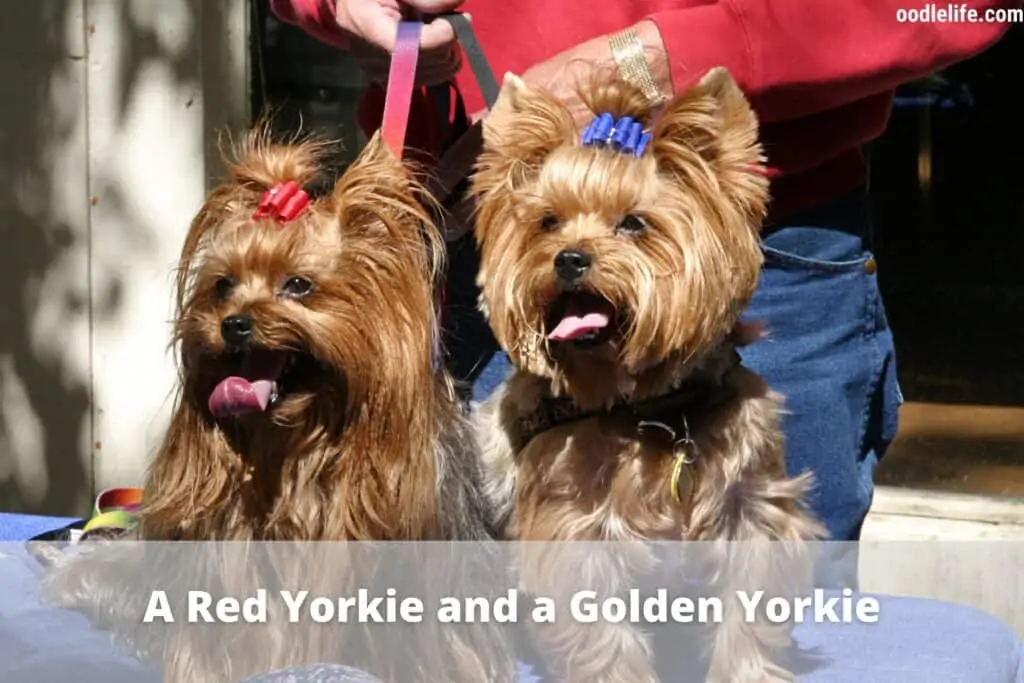
A Yorkie puppy coat has a different color and thickness than an adult coat. There is a transition stage where your Yorkie will go from a puppy coat to its adult coat.
You MAY see the color change that is SIGNIFICANT during this time. (Similar to the reasons that a red Goldendoodle will see golden shift and black Poodles sometimes fade)
The rich and well-defined coat colors will fade as your puppy ages. You will first start seeing the Yorkie coat changing color at around 6 months of age.
How long will the coat keep changing? Well, actually it is quite the process. Expect a two-year transition from puppy coat to adult coat. So anywhere from 1-3 years of age for your Yorkie before the coat is the final adult coat.
Do Yorkie Adult Coats Change as they get old?
Once your Yorkie is an adult and has its adult coat – you will still expect more coat change. This is because the Yorkie coat will lighten further as your dog ages.
Black coats will typically become lighter. Then can transition into blue coats, and even have glimpses of the golden coat.
Tan coats will also lighten to golden.
This also means that chocolate-coat Yorkies will lighten in color and become golden.
What color are the eyes of Yorkshire Terriers?
Yorkshire Terrier Eyes: are black or brown. This is the breed standard. Once in a blue moon, you can get a dark blue-eyed dog. These genes are recessive so this is relatively rare for a purebred Yorkie.
If you want to get a blue-eyed pup then make sure he gets at least 1 parent who carries blue eyes.
Yorkies can also have light brown eyes (often confused or referred to as hazel).
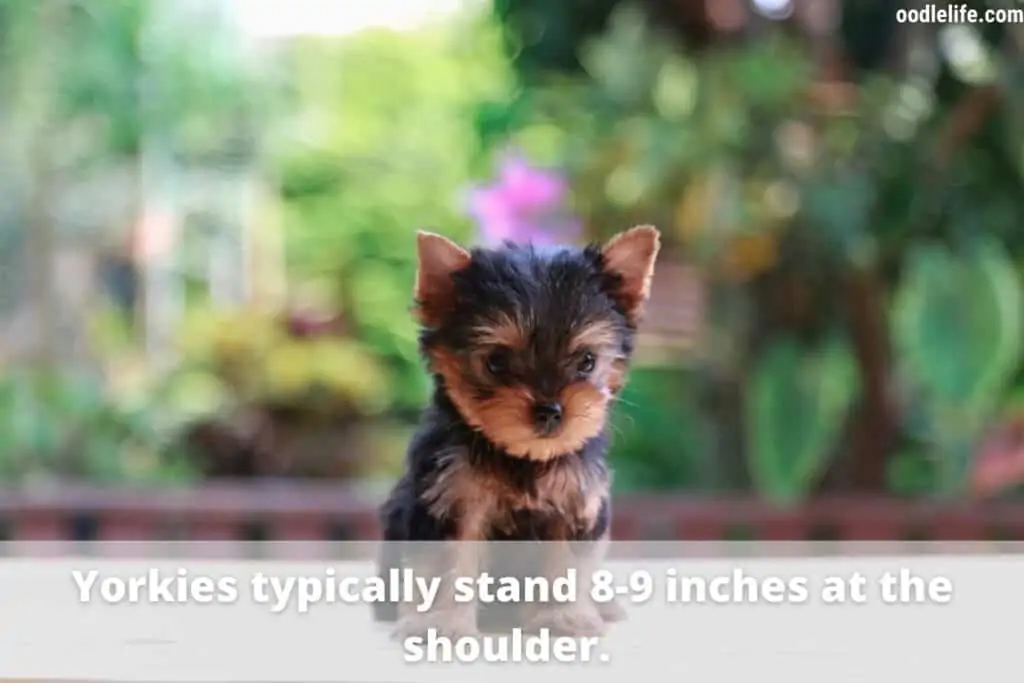
Yorkies have long hair – does it shed?
There is a reason that Yorkies are insanely popular beyond their cuteness and endearing temperament. The answer? Their coat. Yorkies have a single coat. This means that they don’t shed much!
A Yorkie is not the first do you think of when you hear the words “non-shedding” or “hypoallergenic”. We normally think of the Poodle, Labradoodle, and Portuguese Water Dog.
But a Yorkie is actually a relatively low-shedding dog. Even beautiful long-haired Yorkies with a fringe and aplomb won’t drop that much hair.
How often should I brush my Yorkie?
Brushing your pet regularly helps keep his skin healthy and clean. Brushing him once every week is recommended. You may need to brush more frequently during hot weather.
Yorkies do have just a single coat – so brushing is relatively easy. However you can still expect knots and matting.
Key areas that a Yorkie coat will matt include under the chest and around the collar.
Yorkies that visit the beach or pool frequently can see increase in matting and knots. You can use a slicker brush to help remove these mats. A slicker brush works well but some owners prefer using a bristle brush instead.
Abrasive brushes work best for removing excess dirt and debris from the coat.
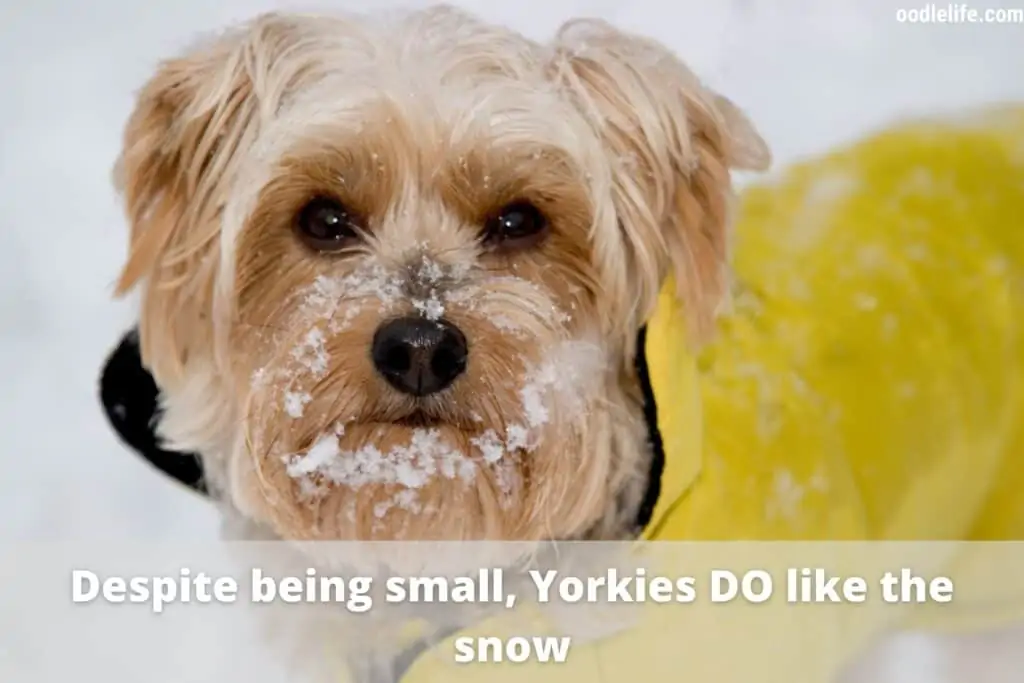
Do Yorkies require special grooming tools?
No. Just regular grooming supplies such as combs, scissors, nail clippers, etc. In terms of a brush, just pick up a great quality slicker brush and a basic stainless steel comb. These will last a lifetime and are no-brainer investments to keep the Yorkie coat happy.
Like many groomers, my favorite slicker brush is Chris Christensen’s medium slicker brush. The quality is high and as result, it is easy to use.
I also use a basic blunt-ended stainless steel comb (this simple one by Andis is a workhorse that will last a lifetime).
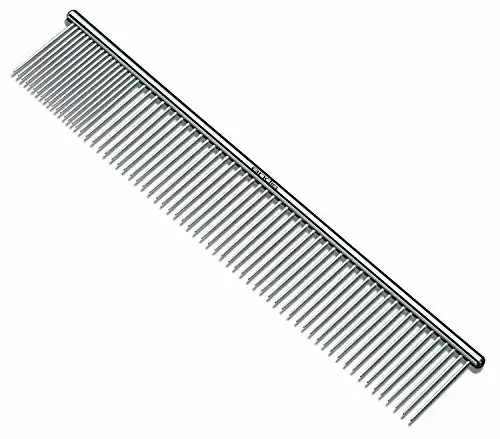
Can I trim my Yorkie’s nails?
Can you? Yes. Should you? Absolutely! Trimming your pet’s nails is important. Most Yorkies that are introduced early to nail clipping will tolerate it.
They don’t *love* the process but it is easy enough.
Some lucky Yorkie owners will have a chillaxed dog that will even tolerate an electric nail filer. These make the process so easy.
Otherwise, basic grooming nail clips will do the trick.
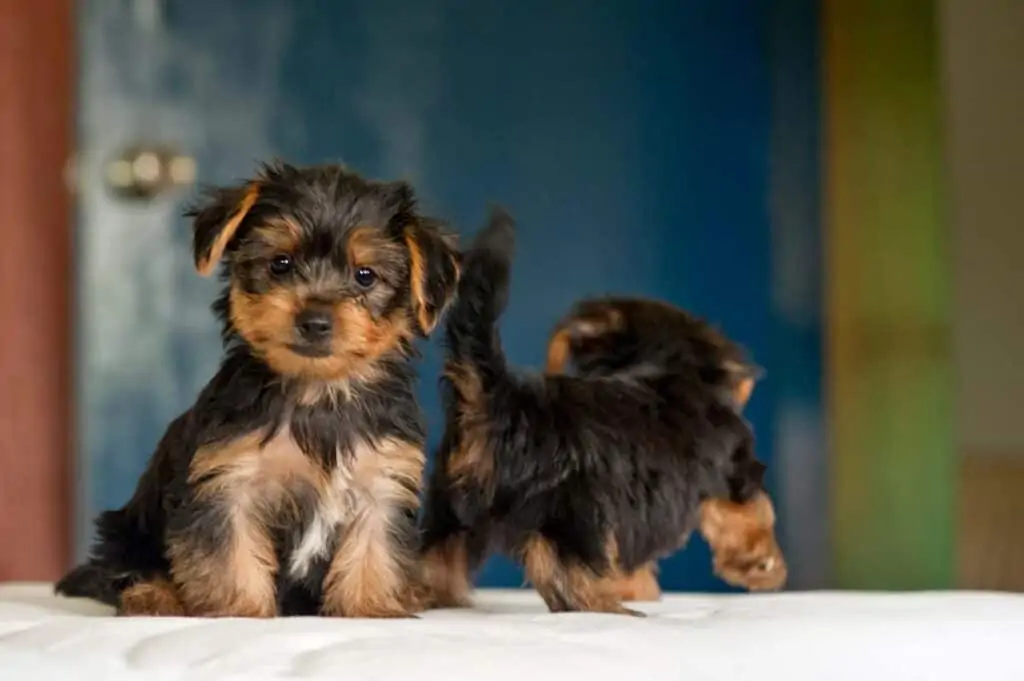
Does the color of Yorkie affect their temperament?
There are some rumors that different color Yorkies have different personalities.
So are red Yorkies even more feisty!? (You should give them a fire name if they are!)
Well… no. All color Yorkies are about the same in terms of temperament. All pure bred Yorkies will have similar temperaments regardless of what color they may be.
The only thing that can change this for Yorkie owners is if their dog is actually crossbred with a *different* breed. Some zany coat combinations are actually due to a Yorkshire Terrier being crossbred with another dog.
These markings and different color coats may in those cases be an indication that Yorkie behavior and temperament may differ from your standard feisty (but loving) Yorkie.
A healthy diet, a bunch of training and consistent home life are the easiest ways to keep a Yorkie puppy happy, healthy, and out of trouble for the long Yorkie lifepsan.
